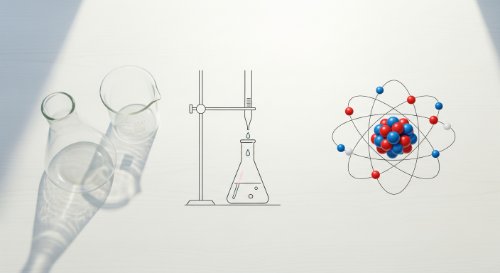Stoichiometry of Composition - Chemistry (Undergraduate Foundation)
8
3 hrs
 CHM 101: General Chemistry IThis learning track delivers the complete NUC CCMAS curriculum for General Chemistry I. It is a comprehensive programme designed to build a robust, university-level foundation in modern chemistry. The track systematically covers all essential topics, from atomic theory, chemical bonding, and the states of matter, to the quantitative principles of stoichiometry, equilibrium, thermodynamics, and kinetics.
This programme is for first-year undergraduates in science, technology, engineering, and mathematics (STEM) faculties who are required to take CHM 101. It is also essential for any student or professional globally who needs a rigorous and complete foundation in first-year university chemistry for further study or career development.
This track delivers a full skill set in chemical theory and quantitative problem-solving. Graduates will be able to determine molecular structures, calculate reaction quantities, analyse the energetics and rates of reactions, and solve complex equilibrium problems. This programme provides the non-negotiable prerequisite knowledge for all subsequent chemistry courses and for any degree in the physical sciences, engineering, or medicine.
CHM 101: General Chemistry IThis learning track delivers the complete NUC CCMAS curriculum for General Chemistry I. It is a comprehensive programme designed to build a robust, university-level foundation in modern chemistry. The track systematically covers all essential topics, from atomic theory, chemical bonding, and the states of matter, to the quantitative principles of stoichiometry, equilibrium, thermodynamics, and kinetics.
This programme is for first-year undergraduates in science, technology, engineering, and mathematics (STEM) faculties who are required to take CHM 101. It is also essential for any student or professional globally who needs a rigorous and complete foundation in first-year university chemistry for further study or career development.
This track delivers a full skill set in chemical theory and quantitative problem-solving. Graduates will be able to determine molecular structures, calculate reaction quantities, analyse the energetics and rates of reactions, and solve complex equilibrium problems. This programme provides the non-negotiable prerequisite knowledge for all subsequent chemistry courses and for any degree in the physical sciences, engineering, or medicine.
This learning track delivers the complete NUC CCMAS curriculum for General Chemistry I. It is a comprehensive programme designed to build a robust, university-level foundation in modern chemistry. The track systematically covers all essential topics, from atomic theory, chemical bonding, and the states of matter, to the quantitative principles of stoichiometry, equilibrium, thermodynamics, and kinetics. This programme is for first-year undergraduates in science, technology, engineering, and mathematics (STEM) faculties who are required to take CHM 101. It is also essential for any student or professional globally who needs a rigorous and complete foundation in first-year university chemistry for further study or career development. This track delivers a full skill set in chemical theory and quantitative problem-solving. Graduates will be able to determine molecular structures, calculate reaction quantities, analyse the energetics and rates of reactions, and solve complex equilibrium problems. This programme provides the non-negotiable prerequisite knowledge for all subsequent chemistry courses and for any degree in the physical sciences, engineering, or medicine.
Course Chapters
1. Introduction21
This chapter establishes the mass scale for chemical measurement. We define relative atomic mass using the carbon-12 standard and determine the weighted average mass of elements based on natural isotopic variance. You will master the course objectives, the carbon-12 reference definition, and the calculation of weighted atomic mass from isotopic abundance data.
Chapter lessons
1-1. Welcome4:48
1-2. Relative atomic mass6:13
2. The Mole Concept21
This chapter introduces the single most important quantitative concept in chemistry: the mole. We formally define this SI unit and establish molar mass as the essential conversion factor for all chemical accounting. You will master the formal definition of the mole, the calculation of molar mass for any substance, and the ability to execute fundamental mass-to-mole conversions.
Chapter lessons
2-1. The mole10:10
2-2. Molar mass15:26
3. Chemical Formulae24
This chapter focuses on converting laboratory mass data into a definitive chemical formula. We cover all analytical methods required to determine a compound's simplest (empirical) and actual (molecular) whole-number atomic ratios. You will master defining empirical and molecular formulae, performing calculations from percentage and combustion analysis data, deriving the final molecular formula, and solving hydrate analysis problems.
Chapter lessons
3-1. Percent composition14:36
This lesson defines percent composition and details its calculation for any compound. We establish why this mass-based ratio is the mandatory initial data for empirical formula determination.
3-2. Empirical and molecular formulae8:14
This lesson formally defines the empirical and molecular formulae. We establish the difference between the simplest whole-number ratio and the actual composition required for compound identification.
4. Conclusion1
This concluding chapter summarises the core concepts of chemical measurement. It reinforces the understanding of the mole and chemical formulae. This summary prepares the student for the next course - Stoichiometry of Reactions - where these accounting tools will be applied to chemical equations.
Chapter lessons
4-1. Summary and practice questions7:06
This lesson provides a comprehensive review of the mole concept, molar mass calculations, and the derivation of empirical and molecular formulae. You will solve integrated practice problems that combine these quantitative tools to ensure readiness for the subsequent course on reaction stoichiometry.